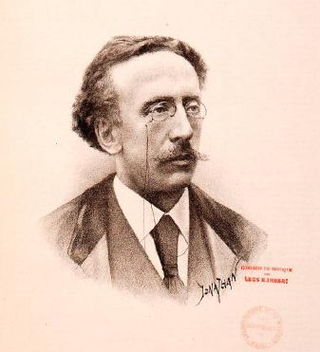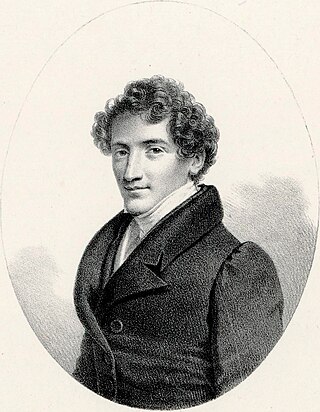Related Research Articles

The Royal Theatre of La Monnaie is an opera house in central Brussels, Belgium. The National Opera of Belgium, a federal institution, takes the name of this theatre in which it is housed—La Monnaie in French or De Munt in Dutch—referring both to the building as well as the opera company. As Belgium's leading opera house, it is one of the few cultural institutions to receive financial support from the Federal Government of Belgium. Other opera houses in Belgium, such as the Vlaamse Opera and the Opéra Royal de Wallonie, are funded by regional governments.

Marguerite Brunet, known by her stage name of Mademoiselle Montansier, was a French actress and theatre director.

(Hyppolyte) Louis Alexandre Dechet was a French actor and is regarded the author of the lyrics of the Brabançonne, the Belgian national anthem. His pseudonym was Jenneval, possibly named after the drama Jenneval, ou le Barnevelt français (1769) of Louis Sébastien Mercier.
Alexandre Bultos was a Belgian comic actor and theatre director.

Joseph-Jean-Baptiste Albouy, stage name Dazincourt, was a French actor.
Jean-Nicolas Servandoni, stage name D'Hannetaire, was a French actor and theatre director.
Herman Bultos was an 18th-century Belgian wine merchant and theatre director.
Jean-Pierre-Paul Adam was a late 18th and early 19th century French actor.

Henri-Joseph Dupont was a Belgian violinist, leader, theatre director (manager) and conductor. The pianist Auguste Dupont was his brother.
Pierre-Antoine Gourgaud, stage name Dugazon père, was a French actor.
Louis Bruyas, stage and pen-name Bursay, was a French actor and playwright. He was a member of the prestigious Académie des Arcades de Rome.

François Ruhlmann was a Belgian conductor.

Jean-Antoine-Nicolas Petipa was a French ballet dancer and the father of Marius Petipa.
Pierre-Louis Stapleton was a Franco-Belgian ballet dancer and choreographer. He was also known from around 1759 by the pseudonym Eugène Hus, after his stepfather Jean-Baptiste Hus.

Henri Albers, born Johan Hendrik Albers, was a Dutch-born opera singer who later became a French citizen. He sang leading baritone roles in an international career that spanned 37 years and was a prominent singer at the Théâtre de la Monnaie in Brussels and the Opéra-Comique in Paris, which was his base from 1900 until his death. He also sang in 36 performances with the Metropolitan Opera company from 1898 to 1899. He made many recordings for Pathé Records and specialised in the heavier baritone and basso cantante repertoire.
Charles François Marie Laffillé was a 19th-century French composer, poet, theatre manager and music publisher.

Jean-Baptiste Marie Chollet was a French musician and operatic singer. He also composed a few romances and nocturnes. He married the opera singer Geneviève-Aimé-Zoë Prévost and their daughter Caroline Chollet also became an opera singer under the stage name Mademoiselle Monrose.

Zina Brozia born Ambrozine Baptiste (1876–1958) was a French operatic soprano who made her début at the Opéra Comique in 1905 and at the Opéra Garnier in 1908. Brozia also performed in Brussels, Parma and Boston.

Jean-Baptiste-Sauveur Gavaudan was French opera singer who sang leading tenor roles, primarily with the Opéra Comique in Paris. He was particularly known for his skill as an actor and was sometimes referred to as "the Talma of the Opéra Comique". He also served as the director of the Théâtre Royal de la Monnaie in Brussels for the 1817–1818 season. Born in Salon-de-Provence, he made his stage debut in 1791 at the Théâtre Montansier. Gavaudan was married to the soprano Alexandrine Marie Agathe Gavaudan-Ducamel from 1798 until his death in Paris at the age of 67.

Marguerite Vaillant-Couturier was a French soprano who made her debut in Brussels at La Monnaie in 1880 in the title role of Gounod's Mireille. After appearing in Marseille the following year, she sang in operettas in Paris in the early 1880s. On 19 October 1882, she created the role of Micaëla in Lecocq's Le cœur et la main at the Théâtre des Nouveautés in Paris. In 1888, she gained success in the title role of Bizet's Carmen at the Opéra-Comique. She also appeared in Buenos Aires and Saint Petersburg.
References
- Henri Liebrecht: Les dernières directions de l’ancien régime, in Histoire du Theatre Français. Slatkine Reprints. Genève 1977.